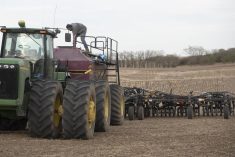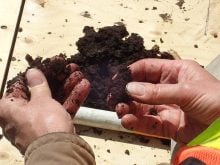The province has announced an Excess Moisture Insurance (EMI) top-up of $15 per acre, providing coverage of up to $80 per acre for land too wet to seed by June 20.
Manitoba Agriculture, Food and Rural Initiatives Minister Ron Kostyshyn made the announcement at Ag Days in Brandon.
“We can’t afford to jeopardize the economic movement in the rural landscape,” said Kostyshyn. “We know that the costs of production have gone up and you know people rely on a fixed income, and we just felt it was just assurance that you’re going to have a guaranteed income, a peace of mind.”
Read Also

Still hard to predict precise fertilizer payback
Despite decades of advances, international research finds no clear answer for where and when adding nutrient will fail to boost growth.
Necessity
The provincial government is still mindful of budgetary concerns, but felt the top-up was a necessity, said Kostyshyn. It will be funded by deferring an increase to wildlife damage compensation, which will remain at 90 per cent this year, the minister said.
“We had to make a tough final decision, and because we believe topping-up options gives a more significant benefit to farmers, we have chosen to do this,” he said.
Now, on top of basic EMI coverage of $50 per acre, producers can choose the $65- or $80-per-acre options. But Kostyshyn noted farmers will only be able to buy their EMI deductible down to five per cent in 2012, rather than zero as in previous years, following new federal regulations requiring all insurance programs to have a deductible. As well, the forage restoration benefit, which provides compensation for damage to forage crops due to excess moisture, will also increase to $70 per acre from $60, he said.
The top-up is something his members have been calling for, said Doug Chorney, president of Keystone Agricultural Producers.
“I think some producers wanted to have the high coverage levels and some producers still want to have the option of baseline coverage,” said Chorney. “Not everyone needs to have $80 coverage, but it’s good to have the option. Those who want it will be pleased.”
Record AgriInsurance payouts over the last two years also mean farmers can expect an increase to premium rates of about five per cent in 2012.
Crop values under the federally and provincially funded program are up an average of 8.7 per cent compared to 2011 levels, requiring an additional $170 million in expected insured coverage, Kostyshyn said.
More than $500 million in indemnities has been paid out over the last two years. The province’s share of 2012-13 premiums is expected to reach $58.86 million, up $8.5 million from 2011-12.
“The 2011 spring flood was unprecedented,” said Kostyshyn. “And it comes with an unprecedented price tag.”
Biomass
The minister also announced a new Manitoba Biomass Energy Support Program, which provides up to $400,000 in grants to encourage coal users to switch to biomass energy.
The program will offer up to $12,000 to coal users to offset costs related to switching to biomass, and up to $50,000 for infrastructure costs. Rural communities, farms and industry are eligible, but must apply to the program by March 9.
“On the Prairies, we have an abundance of biomass in the form of agricultural residue, such as straw, oat hulls and flax shives,” said Kostyshyn. He said the program is part of the province’s biomass strategy aimed at generating revenue while diversifying farm income.
Program funding comes from the coal tax, which came into effect on Jan. 1.
The new tax is a concern for some producers.
“There are a lot of producers interested in biomass and the opportunities that will present us,” said Chorney. “But I’m somewhat concerned about the plan to phase out coal and the coal tax. We do have some producers who still want to have the opportunity and option of using coal in the future.”
As biomass develops in Manitoba, it is important to ensure a structured and well-planned supply chain develops along with it, he said.














